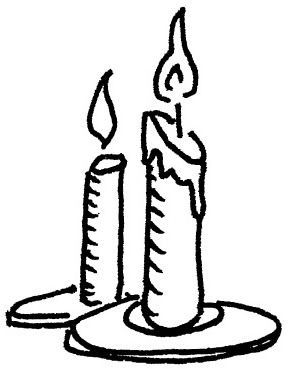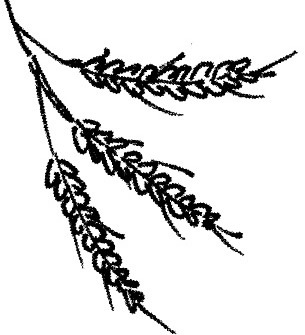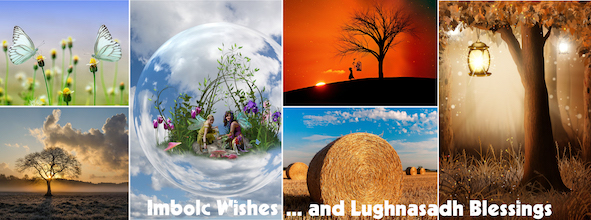Imbolc blessings to my friends in the southern hemisphere. Spring has sprung! Last night on my walk I saw jonquils, and friends have seen snowdrops 🌿💐 Wishing you all the joy, new energy and awakening as the light returns, and you plant the seeds of what you’d like to grow in your life 💕
And Lughnasadh blessings to my friends in the north. May you be filled with love, inspiration and gratitude as you celebrate all you have harvested, achieved and received this year 🍁🌾 Much love to all as the wheel turns 💕
 In the southern hemisphere, Imbolc is the next sabbat of the Wheel of the Year, falling on August 8 in Australia (but super early in the morning – 3:19am in Perth, 5:19am in Sydney). This is the festival that marks the beginning of spring, and celebrates the lengthening of the days and the returning of the light as it illuminates the land and our own hearts.
In the southern hemisphere, Imbolc is the next sabbat of the Wheel of the Year, falling on August 8 in Australia (but super early in the morning – 3:19am in Perth, 5:19am in Sydney). This is the festival that marks the beginning of spring, and celebrates the lengthening of the days and the returning of the light as it illuminates the land and our own hearts.
Mythologically, this was when the goddess transformed into the maiden and waiting bride, signified by the new blossoms and the quickening energy within the earth, and the infant god continued to grow in power, represented by the longer days and increasing strength of the sun. Astronomically, the cross-quarter day of Imbolc falls midway between the winter solstice and the spring equinox. In the southern hemisphere the sun is in the middle of its journey back from the lowest latitudes to the equator, and rises in the same position as it did at Samhain, when it was heading south from the equator towards its Midwinter point.
Energetically it’s a time of awakening, renewal and re-emergence, as nature fills with life force and begins to quiver with the energy to grow again, and we too start to emerge from the chill of winter, shaking off our inertia and lack of motivation and beginning to re-engage with the world. It’s also a time of purification and cleansing after the long dark of the winter months, of stripping away the old so the new can emerge. Imbolc is one of the four fire festivals of the year, and great bonfires would be lit not only in celebration but also for purification, so cleansing has always been an important aspect of the day.
Imbolc is a festival of light, celebrating the return of the sun and its life-giving warmth. It is dedicated to Bridie, the maiden fire goddess, whose transformative flames help purify and burn away doubt and pain. Bridie, also known as Bridget and Bride, was associated with inspiration and creativity, making it a great day to express your inner muse. She was also linked with intuition, and because the ancients believed that the veil between the worlds was thinner on the cross-quarter days, she was invoked for assistance with divination rituals and prophecy at this time, including weather prognostication.
Imbolc remains a day to honour the fertility of the land and our own selves. As the first signs of spring start to manifest, and the earth quickens with an energy that can be tangibly felt, it’s a powerful time to do healing work of any kind, and send energy to friends around the world. You can also increase your knowledge in an area you’re interested in, expand your creativity, and tend to activities that are overlooked in the busy months of summer – making candles, sewing dream pillows, grinding herbs and blessing the seeds you’ll plant in spring.
All over the world the coming of spring is celebrated as a time of hope, renewal and fresh starts after winter’s slowness. In Japan, the Shinto spring festival of Setsubun is celebrated on February 3, recognised there as the first day of spring. Special purification rituals are performed to cleanse away the negativity of the old year and allow the new to blossom into life, and beans are thrown to deter bad spirits.
Chinese New Year is also a spring festival that ushers in new energy and transformation. To absorb its spirit, spring clean your home, throwing out any tired reminders of the old year to make space for the good fortune of the new year to enter. Burn sage sticks or perform a house blessing ritual to clear any negative energies that have settled inside during winter, have a ritual bath and drink cleansing herb teas and plenty of water with a squeeze of lemon to detoxify your body.
As the flowers begin to blossom after winter’s chill, weave a wreath of primroses, dandelions and other spring blooms to wear in your hair, or plant these flowers in your garden to call on the energy and life force of the season. Make Bridie Crosses with stalks of wheat or pipe cleaners to hang around the house as symbols of the goddess and of protection. Light candles and set them in all your windows and throughout the house, then burn white or pale blue candles for your ritual – or simply for your dinner table – to embody the innocence and purity of the day, and represent the purifying power of the element of fire.
For thousands of years, Imbolc has been celebrated with rituals involving the lighting of candles and fires to represent the return of the warmth and light and the slowly increasing power of the sun. To absorb this fire energy, perform some candle magic. Light a white or gold candle and stare into the flame as you concentrate on what you want, then blow it out, sending your desire out to the universe. Making a wish as you blow out the candles on your birthday cake is a magic that has survived from pagan times, and is a potent way to manifest your dreams into reality, whatever day it is.
If you want to hold a simple ritual with friends, sit in a circle, each with a tealight candle. One person lights their candle as they make a wish or a statement of intent, then the next person ignites theirs from the one that is already lit, going around the circle in a deosil (with the sun) direction, which is anti-clockwise in the southern hemisphere, until you have a vibrant ring of fire. The last person should light a large central candle with their tealight, which will absorb and hold the magic of the group and can be lit whenever you are together again.
You can also hold a candle-making party, infusing each waxwork creation with your personal energy, or give everyone a floating candle, light them and set them adrift on a pond or pool, or just in a bowl of water, sending your intentions out into the universe and calling on the magic of all the elements to help you make them come true. Bridie is also associated with sacred wells, so combining the elements of fire and water in this way helps you further absorb her archetypal energy.
Like most pagan festivals, the Church superimposed its own holiday over Imbolc. It turned the festival of the goddess Bridie into the feast day of Saint Bridget, a figure also associated with the sacred flame. To temper the significance of the pagan candle ceremonies, they declared the next day Candlemas, the day the priests bless the church candles. And in the Roman Empire, where candlelight processions in honour of Juno, the goddess of marriage, were held on this day, the Pope created a holy day, the Purification of the Blessed Virgin, marked with a candle ceremony, to honour the day they decided Mary became “clean” again 40 days after giving birth. Each of these new celebrations still incorporated the old traditions of purification, cleansing and fire, so the seasonal associations remained, hidden within the new religion
* * * * *
But in the northern hemisphere it is Lughnasasdh, which marks the first day of autumn and the first harvest festival – in 2019 it falls on August 7. It’s a day of celebrating the things we have metaphorically harvested, the things we’ve achieved, the gifts we’ve received, the experiences we’ve had, the talents we’ve developed and the things we’ve learned… (It’s also the first ritual Carlie takes part in in the Into the Mists series…)
 Lughnasadh, or Lammas, which is celebrated in the first week of February in the southern hemisphere and August in the north, is a cross-quarter day marking the end of summer and the beginning of autumn. It’s the first harvest festival, traditionally a time of feasting and of thanksgiving for the life-giving properties of the grain, as well as a recognition of the cycle of sowing and reaping of the crops – and of the symbolic things you grow and create in your life.
Lughnasadh, or Lammas, which is celebrated in the first week of February in the southern hemisphere and August in the north, is a cross-quarter day marking the end of summer and the beginning of autumn. It’s the first harvest festival, traditionally a time of feasting and of thanksgiving for the life-giving properties of the grain, as well as a recognition of the cycle of sowing and reaping of the crops – and of the symbolic things you grow and create in your life.
It’s a day of harvesting the fruits of your labours and acknowledging your successes and what you’ve achieved in the past year. Celebrate the goals you’ve reached and have your own festival of gratitude, in whatever form that takes. Toast your success, throw a party or do something special to mark the occasion. Make a list of all the things you’ve gained over the past year – the gifts you’ve been given, the new talents you’ve developed, the friends you’ve made, the experiences you’ve had, the healings you’ve received – and give thanks for it all. Then, out of gratitude and in the spirit of the ancestors who shared the bounty of their harvest with those less well off, pass on some of your good fortune. Make a donation to a local charity, lend money to a business in the developing world or give your time to help someone, ensuring the energy of abundance continues and is strengthened. Give out of grace and for joy, not with the expectation of receiving anything in return. Work out small ways you can make a difference to the world and the people around you all year.
As well as a time of feasting and thanksgiving for the harvesting of the crops, and recognition of the eternal cycle of sowing and reaping, Lughnasadh is also about the symbolic things you grow and create in your life. It’s a day to harvest what you planted earlier in the year and celebrate your successes. Make a list of all the things you’ve gained – the goals you reached, the gifts you’ve been given, the new talents you’ve developed, the friends you’ve made, the experiences you’ve had, the healings you’ve received, the opportunities you’ve pursued – and how you have developed and changed as a result of them.
Create a ritual of appreciation that is meaningful for you. You may want to journal about it, exploring in depth the things you’ve learned and the ways in which you’ve grown, send thank you cards to people who have helped you work towards your goals, start a gratitude diary or write a poem that outlines all that you’re grateful for. We may no longer be so connected to the production of our food, as in days gone by, or believe that our prayers or sacrifices influence the success of a crop, but appreciating what we have and giving thanks for it is still a beautiful way to live, and can increase our own attitude of abundance.
Also acknowledge all the things you’ve achieved so you can share your successes with others. Don’t be modest or downplay how far you’ve come, because you’ll inspire other people with stories of your breakthroughs, your dedication and details of how you overcame the obstacles you faced. Your successes will help them realise they can also pursue their dreams, and will hopefully give them the motivation they need to get started on their own journey.
Don’t ever diminish yourself or your achievements, or let anyone else do so. Be proud of your light, your talents and all your accomplishments, and always allow yourself to shine brightly and illuminate the darkness for others. As American author Marianne Williamson says: “Your playing small doesn’t serve the world. There’s nothing enlightened about shrinking so that other people won’t feel insecure around you. We are all meant to shine, and as we let our own light shine, we give other people permission to do the same.”
Now too, as the energy begins to subtly slow, it’s a time to be patient and to trust that everything is as it should be, because there are still harvests to come. Not everything has to be achieved right now – some things take longer to manifest. The lesson of the Wheel of the Year is that everything continues, everything happens when it should and everything is eternal.
Edited excerpts from A Magical Journey – Your Diary of Inspiration, Adventure and Transformation.



Get Social